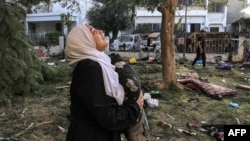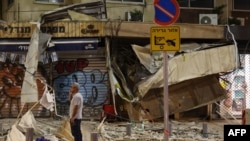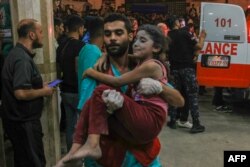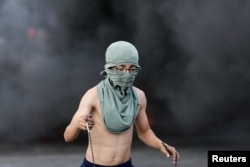On October 7, Hamas unleashed the bloodiest single-day massacre of Jews since the Holocaust. Since then, violence in Israel, Gaza and the West Bank has soared to an unprecedented high.
For reference, more Palestinian and Israeli civilians have perished in fewer than two weeks of battle than in all the 50 days of fighting in the 2014 Gaza War. Just this week, hundreds of Palestinians were killed in a blast at a Gaza hospital.
Here are the key facts to know about the bloodshed in the region.
What happened on October 7?
A spokesman for the Israel Defense Forces, or IDF, described October 7 as “by far the worst day in Israeli history.” Political pundits across the globe have likened the tragedy to 9/11 and Pearl Harbor in the United States.
Hamas’ brutal terrorist assault on everyday Israelis took the world by surprise. Most of the militants infiltrated southern Israel through a bulldozed stretch of barbed wire fence that surrounds the Gaza Strip. Some of the fighters flew over the border using motorized paragliders.
The attack was cunning and vicious.
Hamas tore through Israeli towns, burning down houses as families cowered inside. They fired on revelers at a music festival and took off with dozens of civilian hostages, as many as 13 Americans among them. They tossed grenades into bomb shelters, slaughtering Israelis indiscriminately.
The list of horrors detailed in eyewitness accounts goes on. In all, more than 1,400 Israelis were murdered, the vast majority of whom were civilians. A further 3,400 were injured.
In response, Israel has bombarded Gaza with missiles and airstrikes, leveling entire city blocks, and has cut off the influx of fuel, food and electricity into the strip. Gazan casualties are expected to spiral as Israel, vowing to overthrow Hamas, prepares a full-scale military invasion of the enclave, home to 2.1 million Palestinians.
“In any case, there are going to be no winners in this,” Tahani Mustafa, the Palestine senior analyst at the International Crisis Group, told VOA. “[The war] will probably take weeks to months, with lasting repercussions on both sides.”
Humanitarian crisis in Gaza
With newsreels circulating on social media showing entire residential complexes and mosques reduced to rubble, the world has a sense of the devastation in Gaza.
As of publication, nearly 3,500 Palestinians have been slain and a further 12,000 have been wounded by Israeli missiles, Gazan authorities say. After a hospital in the strip was blown up, reportedly killing at least 471 Palestinians, the IDF and Gazan officials are pointing fingers at each other.
The IDF and the White House say that a misfired rocket out of Gaza was the cause, but the strip’s health ministry claims it was an Israeli strike.
No matter who is to blame for the calamity, the sheer human misery in Gaza is clear.
An estimated 1 million Gazans have been displaced from their homes. Nearly half of Gaza’s population are children, who are especially vulnerable as fighting becomes even fiercer, activists warn.
On average in Gaza, one child is killed every 15 minutes, according to Save the Children, a U.K.-based humanitarian nonprofit.
“If Israel wants to go in and destroy Hamas, it probably can do it, but we’re talking about hundreds, if not more, Israeli casualties as well as probably thousands more Arab civilian casualties,” said Paul Scham, a scholar at the Middle East Institute. “How to tell civilians apart from soldiers is itself a difficulty.”
David Silbey, a professor of military history at Cornell University, agreed with Mustafa that the war could drag on for weeks — and it will likely be bloody. “I think what Hamas wants to do in military terms is not necessarily hold Gaza physically but inflict as much damage and as many casualties on the IDF as they can.”
Still, Silbey predicted that Hamas will bear the brunt of the fighting because the IDF has better armored protection.
“This is not a war of terrain. It’s a war of agility. It’s a war of killing people,” Silbey said. “As we saw with the initial Hamas attack, the focus was not on holding the areas of Israel that they invaded but on slaughtering and murdering as many people as they could.”
Silbey told VOA that Hamas’ goal is to demoralize the Israeli public to the extent that “they start to think about whether it’s worth the fight.”
And if Israeli Prime Minister Benjamin Netanyahu ultimately succeeds in his mission to “crush” Hamas, experts want to know: What then?
The question of what Israel’s strategy will be should it accomplish its goal of at least temporarily capturing Gaza City remains. Nobody can say with certainty what life will look like for the average Palestinian living in Gaza, although the prognosis is bleak right now.
What happens in the coming weeks, experts say, will shape the future for both Israelis and Palestinians and set a precedent for how subsequent conflicts play out.
“If [Hamas] fails, then it will signal the end of armed resistance [for Palestinians],” Mustafa said.
West Bank, East Jerusalem violence
The IDF’s air campaign in Gaza has raised a furor in other Palestinian-administered enclaves. Analysts are concerned that widespread tumult may boil over, opening new fronts in the Israel-Hamas War.
Palestinian health officials have reported that at least 56 Palestinians have been killed and 1,100 wounded in the West Bank and East Jerusalem in clashes with Israeli officers and in ambushes by armed settlers.
The past week was the most fatal for Palestinians in the West Bank in nearly two decades, the United Nations said. The last two years have seen skirmishes between settlers and Palestinians surge. As Netanyahu’s ultra-conservatism has gained more sway in Israeli politics, experts say nationalists have been inspired to expand into the West Bank, often with deadly force.
Palestinian militants in the West Bank have turned to smuggling weapons to fend off threats, vie for power and occasionally attack Israel. The Palestinian Authority’s control of the region is beginning to slip as mayhem mounts.












